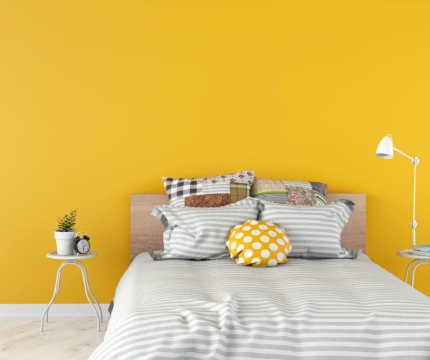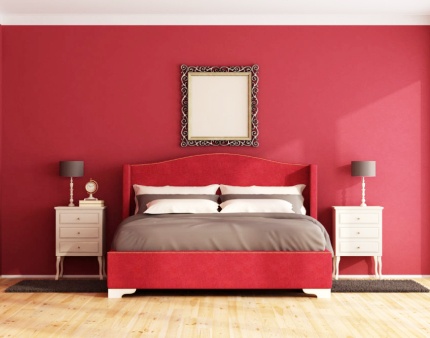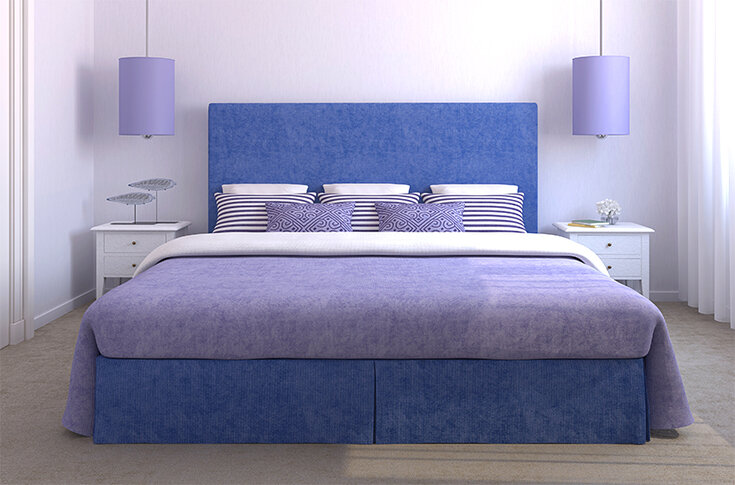Regardless of whether you believe it or not, color has an immense effect on our brains. That is why we should be cautious when we are choosing colors for our home interior, especially for such an important room as the bedroom.
A good night’s sleep is essential for our good mood and happiness, so everything that we bring inside the bedroom should be helping us sleep better, or at least not prevent us from that.
Here is a complete guide for you if you are wondering what are the best colors for a bedroom.
Are There Colors that can Make you Sleep Better
Color is not something that can put us to sleep directly, but it can help our brain relax, which is a factor for healthy sleep.
Below we will have a look at those colors and nuances that are the best in helping us relax.
Neutral Palettes
Muted pastel tones and neutral colors like very desaturated versions of the primary colors are always a good choice for rooms that need to provide relaxation.
Such color palettes help us calm down and go into a healthy sleep because they do not overstimulate the senses. The reasons for the effect of color on our brains are not just a made-up theory but are rooted in neurology and psychology, and even biochemistry.
A neutral palette is great if you want to add a few pops of color for additional elegance.
Calming Blue
The color of the sky has natural calming properties due to its cold color temperature and serenity. You can choose between lighter or darker shades according to your tastes and requirements, but be careful with shades that are too dark, like navy blue, because they might create a sense of coldness instead of coziness.
You can choose one wall and paint it in a different shade of blue for variety and style, or go two by two. Choose different shades of blue for your bed linen than the main one that you used on the walls.
Happy Yellow
 Yellow is not the typical color associated with sleeping, as it has more energizing than relaxing properties, but a nice soft shade of yellow, such as Naples yellow, will uplift your mood and bring you coziness and a sense of warmth for a good night’s sleep.
Yellow is not the typical color associated with sleeping, as it has more energizing than relaxing properties, but a nice soft shade of yellow, such as Naples yellow, will uplift your mood and bring you coziness and a sense of warmth for a good night’s sleep.
It is a good color for baby bedrooms too. A mustard yellow is also a good muted nuance you can use in bedrooms that is also one of the most elegant and noble nuances out there due to its resemblance to gold.
Avoid bright hues of yellow because the brain associates them with sunlight and wakes up, instead of preparing for sleep.
Relaxing Green
Green is the color most present in nature, which is why it has calming properties on our brains. Brighter shades of green can help you concentrate and become more productive, but they can also remind the brain of a calming deep forest and help you go into a state of deep healthy sleep.
In the long run, green has a general harmonizing effect on your whole being. Just avoid the more vivid green tones and choose more subtle and gentle ones, because you might get energized instead of relaxed.
Purples and Soft Pinks
Purple is a gentle and serene color, associated with intelligence and royalty. Purple and pink are proven to affect our mood positively and relieve anxiety.
With these colors, you should again aim at more subtle nuances like lilac, beige, and blush pink. Avoid aggressive nuances like magenta and leave them for the living room for example.
Choose these nuances for your walls, your curtains, bedroom linen, or some of the decorative elements in the bedroom.
Careful with Black
Black is also a color some people choose for their bedroom, but if you place it on all four walls, it could have a negative effect on your mood and mental health. On the other hand, if you use it sparingly, it can calm you down.
Choose two or three walls to paint black, and paint the other walls in a different neutral nuance.
What About Red
 Although you probably don’t associate red with sleep and relaxation, actually some shades of deep dark red are a good choice for a bedroom that acts positively on your mood. Of course, avoid the bright and vigorous shades if you don’t want your sleep to suffer.
Although you probably don’t associate red with sleep and relaxation, actually some shades of deep dark red are a good choice for a bedroom that acts positively on your mood. Of course, avoid the bright and vigorous shades if you don’t want your sleep to suffer.
Worst Color Choices for Bedrooms
Besides bright red, all bright nuances of colors should be generally avoided in bedrooms’ interior design. Avoid neon nuances at all costs.
Nuances that are too dark are also not advisable because they could evoke negative moods and anxiety.
Generally, all the colors you choose for the different elements of your bedroom’s interior should be ones that make you feel calm and placid.

My name is Scarlett Mitchell and i am an author and editor in the home topic website – FemCasa.com.
I’m just an enthusiast who wants to share her visions, ideas and advices, when it comes to decorating every part of your home until it becomes the perfect relaxing place for you and your family.

